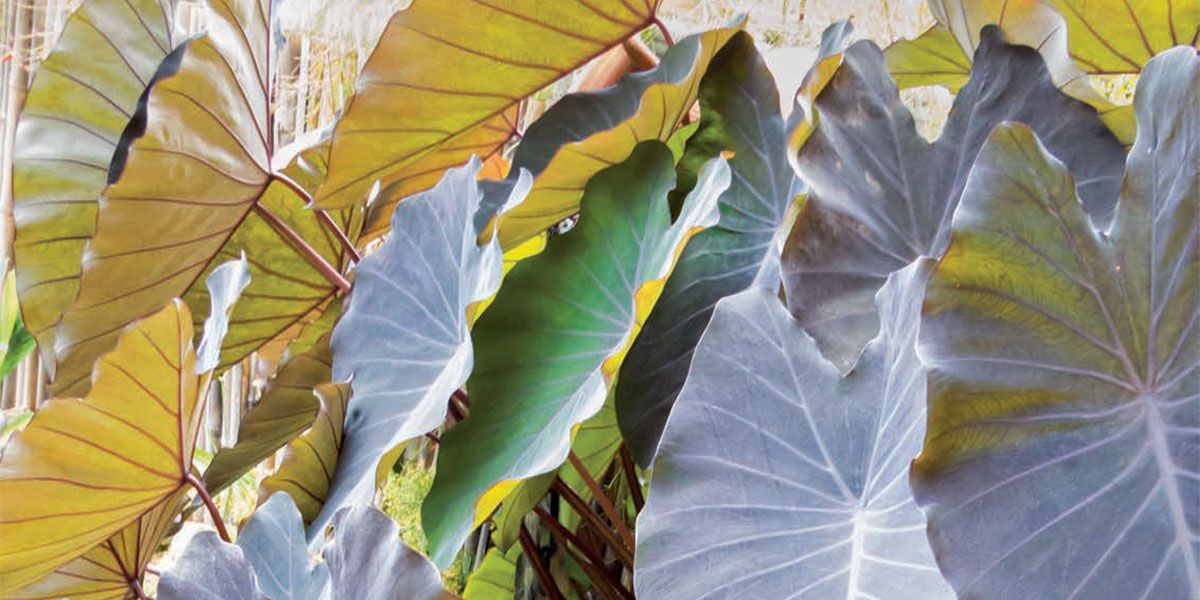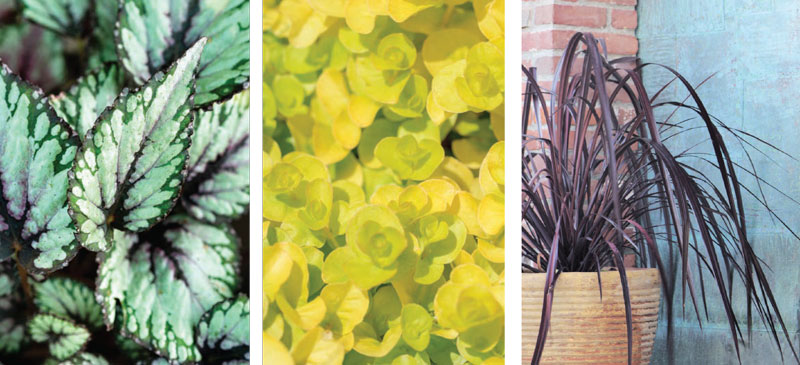Foliage Container Gardens | Just the Leaves, Please

While flowers are lovely, have you ever stopped to think about what the real stars of your container gardens are? Consider the foliage—the plants that often get added as filler but really anchor the whole arrangement, adding contrast, texture and interest without offering blooms. This year why not skip the flowers and go straight to the foliage? Blooms come and go, often requiring deadheading, while leaves stay true all season long, making the case for a foliage-only container garden.
When assembling your container garden, consider what look you are going for. Elephant ears are fabulous as the centerpiece in a container because of their large size, but they require a big pot. Fill in around them with more medium-sized plants, such as coleus or coral bells, then use draping plants like creeping Jenny or sweet potato vines around the edges. Caladium, available in shades of white, green, pink and red, are another excellent container centerpiece, as they grow to only about 18 inches instead of the 6 feet that an elephant ear can reach, creating a similar impact without the space requirements.
Foliage-forward plants
There are a few well-known perennials in your garden that are excellent candidates for foliage container gardens, including coral bells and hostas. Both plants come in various shades, while hostas offer a variety of textures and shapes. A notorious favorite of deer, hostas are far easier to protect when planted in containers. Ornamental grasses and ferns are other plants to be considered for foliage container gardens. Grasses in particular can add the element of height, while the plethora of ferns available (over 12,000 varieties!) suggest one could have numerous fern-only planters.
When considering plants with interesting or colorful foliage, coleus is at the top of the list. The sheer number of varieties available with different leaf shapes, colors, textures and sizes is hard to keep track of, making it one of the most versatile plants out there. Speaking of colorful leaves, rex begonia also comes in a wide array of shapes, patterns and colors. Then there is the show-stopping Persian shield with its iridescent purple leaves as well as the lacy, silver-leaved dusty miller. Often added as background in container gardens as contrast to blooming annuals, these plants can anchor a foliage planter on their own with their dynamic appearance.
For trailing plants with color, the purple heart (setcreasea), with its distinctive purple blade-shaped leaves, adds instant punch to any container, offering a small pink bloom upon occasion. The golden leaves of creeping Jenny or the various shades of sweet potato vine, available in golds, browns, burgundy or variegated, are other colorful trailing options, helping to soften the edge of your container while adding some punch and depth to it.
Foliage container gardens don’t just have to be pretty; they can be useful too. Why not add some herbs or other edible plants? Ornamental kale is a popular cool-weather container plant, but other types of edible kale are also incredibly interesting in appearance. Dinosaur kale, which is slightly blue, or Redbor kale, with its frilly magenta leaves, make for good-looking edible additions, while Swiss chard, particularly the rainbow cultivar, is another. Herbs are another consideration for edible additions in a foliage garden. Purple sage, parsley, rosemary, chives, and golden oregano are just a few of the many herbs that are as easy to grow as they are attractive. Many gardeners consider containers the only way to grow mint and many of its relatives, as the hardy herb is known to be slightly invasive when it has found a happy spot to grow. Chocolate mint, with its brown stems, has a darker green leaf than most mints, and features the aroma of chocolate. Pineapple mint, with its variegated leaves, is another interesting addition to a container without fear of it overtaking your garden.
When assembling your foliage container, keep in mind where it will live. If you are looking to put a foliage container garden on a front porch that gets afternoon sun, avoid including ferns and other shade-loving plants. The ferns will do much better in a container garden on a screened porch that gets indirect light all day. Consider the scale as well; dwarf ornamental grasses will not require as big a pot as larger varieties or even elephant ears. You’ll want to provide space for your plants to spread out over the season, so plan accordingly.
Many of these plants can be grown both as perennials or as annuals, so with a bit of extra care, your foliage container garden can last much longer than one growing season. A container garden that lasts year in and year out with minimal effort seems too good to be true, but it might just be one of the best-kept gardening secrets. ✦
Caladium, Chocolate mint, coleus, coral bells, creeping Jenny, edible plants, Elephant ears, Foliage Container Gardens, Hostas, Ornamental grasses and ferns, ornamental kale, Persian shield, Pineapple mint, purple heart, rex begonia, sweet potato vines, Swiss chard







